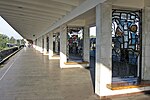Borys Grinchenko Kyiv Metropolitan University

Borys Grinchenko Kyiv Metropolitan University (Ukrainian: Київський столичний університет імені Бориса Грінченка) is a higher education institution. The university was established by Kyiv municipal council through reorganization of Kyiv regional Teachers Training Institute named after Borys Hrinchenko. The university is communal property. According to the decision of Kyiv municipal council of 8 October 2009 Kyiv Municipal Pedagogical University named after Borys Grinchenko was renamed Borys Grinchenko Kyiv University and its status changed. The university was transformed from a pedagogical profile to a multi-profile classic educational institution. This enabled it to expand its activities and have more majors, ensuring full satisfaction of educational requirements of Kyiv dwellers, meeting the needs of Kyiv and its region. In implementing these tasks the university's activity is aimed at achieving high standards and becoming a European-level institution. The university consists of six institutes, four faculties and one university college with more than 9,000 students. There are 35 operating departments. The scientific-pedagogical staff includes 49 PhDs, 184 EdSs, and 434 teachers. The university offers 10 masters, 12 specialist and 12 bachelor level programmes. Each year around 6000 teachers and school principals enhance their skills and gain qualifications at the university. The university gives PhD training.
Excerpt from the Wikipedia article Borys Grinchenko Kyiv Metropolitan University (License: CC BY-SA 3.0, Authors, Images).Borys Grinchenko Kyiv Metropolitan University
Kyiv
Geographical coordinates (GPS) Address Nearby Places Show on map
Geographical coordinates (GPS)
| Latitude | Longitude |
|---|---|
| N 50.5136 ° | E 30.6581 ° |
Address
07416 Kyiv
Ukraine
Open on Google Maps











